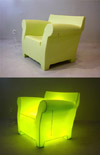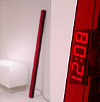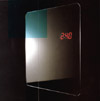 |
||
| softcore news < studios < articles < hardcore firms < jobs < schools < links < calendar < sources < discussion < how to < |
||


> > archived articles > write for core! be famous!
|
An interview with
New York designer..... Much of Tobi Wong's work plays between concept and beauty, exposing
the similarities between art and design rather than blurring their
boundaries. Unlike purely conceptual work-which often lacks a real
appreciation for beauty, aesthetics, and a desire for consumption-his
work often finds expression in real objects. He's coined the term
Paraconceptual to describe it: "Of, relating to, or being conceptual." C77 - You are successful as an independent artist/designer. Any tips for our readers on how to become successful themselves? Was there any one thing that really helped you in your career? TW - Success is relative at this point. People think I'm set-that I'm making the big bucks. But I still find myself opening cans of beans and funneling all my money into other projects (not to mention past student loans.) I found juggling full-time work and full-time school very challenging, but it worked extremely well for my areas of interest. I would suggest it for those in the same fields of art and design. Bouncing ideas in a class critique and them executing them at work, and then back again was the best thing I was able to do. And it worked well, because I needed to work to keep my projects funded at school. A lot of my work is successful. The best are the ones that don't pay the bills, of course. Like my Burberry buttons. I was so happy with that project. They were visible everywhere, in magazines and billboards. It was like my own little exhibition without the confines of the traditional gallery, without all the bullshit. I'd be lying if I said, "Just do what your heart tells you, stay true to yourself, and things will eventually come." That's bullshit. It's all about strategies and risks. C77 - Do current furniture aesthetics of clean lines, simple forms, and surface treatments lend themselves to conceptual expression? Does it simply leave the object clean for meaning or is it essential to what is being said? What is going to happen when ornament makes a return? TW - Ornament made a brief appearance recently and was well received. Many may have missed it, but it will be back, and judging by its past success, will only come back stronger and better. In a way, we're not ready to marry the two distinct styles yet, but we're getting familiar with their basic vocabulary. Nest magazine is a good example of modern ornamental use. For now, the clean lines you're talking about do lend themselves well to conceptual expression. It's a good way to prime the design world to new ideas. Ideas are the new trend. The art world is a little farther ahead on this point, but not by much. Leaving room for meaning is a cheap cop out-the best designers/artist have always been focused on what and how they want to be read. Leaving room for meaning is for those not so confident with their ideas. |
 This is a lamp - 2001  On/Off Installation - 2002  Walter Wayle III - 2002   I want to change the world - 2002  Untitled (a painting) - 2002 additional writing and images: www.brokenoff.com |
|
C77 - Can you tell me a bit about the on/off installation at ICFF? How was coordinating a multi-site installation? Was the multiple crucial to the piece? TW - Coordinating the on/off installation needed a special talent of its own. I had to approach each gallery/showroom with a different strategy. I had to sell them back their own style with my idea. Romantically, it was very successful. All I wanted to do was break down the barriers within our own design community, the one I had gotten to know. When you sell work to one company, it's usually considered taboo to be represented by another. There's a lot of friction caused by exclusivity. I wanted the challenge of having one identical product in many competing stores, and, to further the challenge, I pushed it with something that turned out to be product-less. Most everyone enjoyed the idea and accepted the installation-Diesel created a special denim lamp for the occasion. I was extremely happy with this project. It was successful-but canned beans still give me gas. C77 - Tell us about your new gig with Troy. How did this come about? What are you planning? TW - Troy Halterman (owner of the TROY store in SoHo, New York) requested a copy of my book for his showroom to exhibit during the 2002 ICFF. The day before his opening, I swung by the store (without an appointment) carrying two glass chairs I had just finished. He took those from me on the spot and included them in the show. He told me to invoice him without even asking for numbers. I was impressed with his charisma. Shortly after the ICFF, he asked me to design a collection of 10 products. I told him that I was interested in projects that dealt with the ready-designed, consumerism/consumption, and the border between art and design. I proposed to curate a collection of 20 products: one third my own, the rest from other artist/designers or things that I liked. A few of my 20 favorite things became a few of my 50 favorite things. Today, seven weeks into the eight-week project, we have edited the collection down to 30-something, with one installation and one unique gift-wrapping service. I've taken the opportunity to really give his image a kick, which has never been discussed, but I think that's the main reason I was asked to do the collection. C77 - Can you describe the "unique gift-wrapping service?" TW - The TROY exclusive gift-wrap service is the thing I'm most excited about: "We will wrap your purchase with an original Andy Warhol print." It's ridiculous, but works in so many ways. It speaks to the idea of luxury consumption (the price will be between $5000 and $20,000 per wrap), and the marketing strategy really extends Warhol's ideas on consumption. I want to remind people why we appreciate his work and what made it great. We seem to forget the major reasons why we like certain artists and what they did. It's gotten to the point where work is like symbols we recognize as good or bad, but with no real explanation. I wanted to counteract that. I believe that Warhol would very much approve of this project-its all about his ideas. C77 - Furniture/housewares is the typical cross-over point for artists into design, not to mention those legions of architects. Why? Specifically why for you? TW - Because people are actually listening there. It's also neutral ground that is open to everyone. It's non-threatening and very forgiving. C77 - Any thoughts about how other areas of "traditional" industrial design, like automotive, sports equipment, packaging, etc., might be affected by this cross-over? TW - It shakes them up. Now that artists and designers are crossing over to other disciplines within industrial design, everyone is forced to learn from the other. Competition is good. Romantically-speaking, one day everyone will know how to design everything-but then not everyone will choose to do so. This will make us better consumers, communicators, etc. and, in the end, better thinkers. But we're very far away from that fairytale. C77 - About your new book-Karim's a big dude, and that paper gun won't help much when you two meet up. Have you any secret kung-fu shit that you'll unleash on him? TW - As a matter of fact, I'm close to a black belt. My father started teaching me as a young child. But I still wouldn't like to tick Karim off-he's a big guy. I approached him myself and told him that my book wasn't a personal attack on him or his designs. It's really about post-9/11. His book just seemed to be the most vulnerable at the time, with its title, I WANT TO CHANGE THE WORLD, which at this time seems a little too stupid to even be romantic. I'm also tired of everyone forcing themselves to move on after 9/11. It's not often that the whole world gets to wake up at once. It seems like a perfectly good time to take back a few ideas and ways of thinking without being otherwise embarrassed about them later. I'm not claming to have the answer on what happens post-9/11, and what will become of art and design. But it sure intrigues me. I wanted to mark it. Another interesting deal about the book is that my publisher, Robert The, is actually the original artist who cuts books into guns. He's very well known in the art world and is collected by the MoMA, Walker, and others. So it was a real privilege to have him do my book. Within my work, that's like killing two birds with one stone. C77 - Talk to us about a few more of your projects... The mirror/clock derived from my desire to create a painting. I've tried before, in the traditional sense, but failed. So I reexamined what a painting consists of-background, middle ground, and foreground. I used design elements instead of paint, and voilˆ, the mirror/clock. It's also the only object that I've titled, "untitled" to give it a traditional reference. Walter Wayle III was another fun attempt to exercise the ready-designed that I've been working with. Instead of using another well-known design piece, I borrowed a design's name. WW II is Starck's clock with no face, just hands. Alessi made it, but it's been long discontinued. I thought it would be interesting to call my new clock, with no hands, a reincarnation of Starck's clock. |
|
|
>> back to top >> back to core |
|